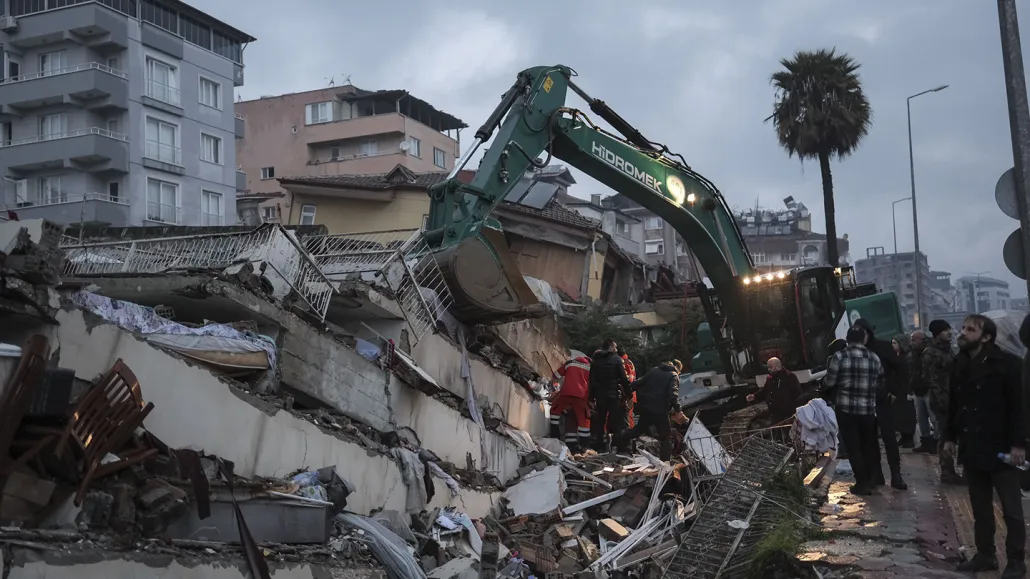
A powerful magnitude 7.8 earthquake struck southern Turkey, including the province of Hatay (shown) on February 6, setting off a desperate race for survivors.
Ercin Erturk/Anadolu Agency via Getty Images
- More than 2 years ago
In the early morning of February 6, a devastating magnitude 7.8 earthquake struck southern Turkey, near the border with Syria. Numerous aftershocks followed, the strongest nearly rivaling the power of the main quake, at magnitude 7.5. By evening, the death toll had climbed to more than 3,700 across both countries, according to Reuters, and was expected to continue to rise.
Most of Turkey sits on a small tectonic plate that is sandwiched between two slowly colliding behemoths: the vast Eurasian Plate to the north and the Arabian Plate to the south. As those two plates push together, Turkey is being squeezed out sideways, like a watermelon seed snapped between two fingers, says seismologist Susan Hough of the U.S. Geological Survey.
The entire country is hemmed in by strike-slip, or sideways-sliding, fault zones: the North Anatolian Fault that runs roughly parallel to the Black Sea, and the East Anatolian Fault, near the border with Syria. As a result, Turkey is highly seismically active. Even so, Monday’s quake, which occurred on the East Anatolian Fault, was the strongest to strike the region since 1939, when a magnitude 7.8 quake killed 30,000 people.
Science News talked with Hough, who is based in Pasadena, Calif., about the quake, its aftershocks and building codes. The conversation has been edited for length and clarity.
SN: You say on Twitter that this was a powerful quake for a strike-slip fault. Can you explain?
Hough: The world has seen bigger earthquakes. Subduction zones generate the biggest earthquakes, as much as magnitude 9 (SN: 1/13/21). But quakes close to magnitude 8 are not common on strike-slip faults. But because they’re on land and tend to be shallow, you can get severe … shaking close to the fault that’s moving.
SN: Some of the aftershocks were very strong, at magnitudes 7.5 and 6.7. Is that unusual?
Hough: As with a lot of things, there’s what’s expected on average, and there’s what’s possible. On average, the largest aftershocks are a full unit smaller than the main shock. But that’s just average; for any individual main shock, the largest aftershock can have a lot of variability.
The other thing people noted was the distance [between the main shock and some aftershocks over a hundred kilometers away]. Aftershock as a term isn’t precise. What is an aftershock isn’t something that seismologists are always clear on. The fault that produced the main shock is 200 kilometers long, and that’s going to change the stress in a lot of areas. Mostly it releases stress, but it does increase stress in some areas. So you can get aftershocks along that fault, but also some distance away. It’s a little bit unusual, but not unheard of.
SN: People have wondered whether Monday’s magnitude 3 earthquake near Buffalo, N.Y., might be related.
Hough: A magnitude 7.8 quake generates [seismic] waves that you can record all around Earth, so it’s technically disrupting every point on Earth. So it’s not a completely outlandish idea, but it’s statistically exceedingly unlikely. Maybe if a seismic wave passed through a fault that was just ready to go in just the right way, it’s possible.
An interesting [and completely separate] idea is that you might get earthquakes around the perimeter of the Great Lakes [such as near Buffalo] because as the lake levels go up and down, you’re stressing the Earth’s crust, putting weight on one side or the other. That’s a source of stress that could give you these pretty small quakes.
SN: The images emerging from this deadly disaster are devastating.
Hough: It’s hard to watch. And it hammers home the importance of building codes. One of the problems that any place is up against is that building codes improve over time, and you’ve always got the problem of older structures. It’s really expensive to retrofit. I expect that earthquake engineers will be looking at the damage, and it will illuminate where the vulnerabilities are [in the area]. The hope is that with proper engineering, we can make the built environment safe.






